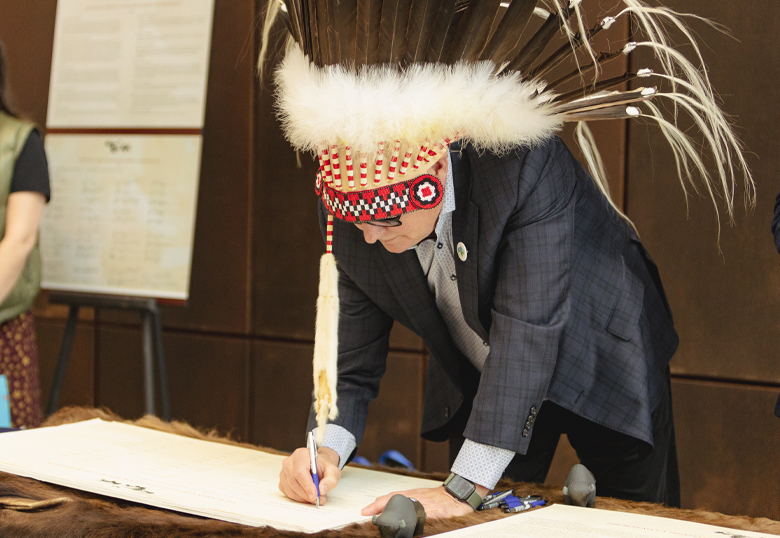What began as conversations between a University of Lethbridge graduate student and Blackfoot elders more than a decade ago came full circle Wednesday when the University became the first post-secondary institution to sign on as a supporter of the historic Buffalo Treaty.

President and Vice-Chancellor, Dr. Mike Mahon, signed the treaty as part of ULethbridge’s annual Indigenous Awareness Week activities, joining the City of Lethbridge, with members of city council and Mayor Blaine Hyggen, and the Piikani Nation, represented by Chief Troy Knowlton and members of council, as signatories.
“The name of our university is Iniskim, which means sacred buffalo stone, and why we were given that name by Elder Bruce Wolf Child in 2001 relates to the historical relationship between where the university is located and the sacred buffalo stone,” says Mahon. “For us to be here today to sign on to the Buffalo Treaty is very important and exciting because it continues to build upon the efforts and traditions this university has undertaken for many years in its relationship with the Blackfoot and all Indigenous Peoples.”
The Buffalo Treaty, a treaty of cooperation, renewal and restoration, was born out of graduate research work Paulette Fox (MSc ’05) was conducting in environmental science. Her conversations with elders included the issue of the buffalo and its importance in Indigenous culture.
“The elders were saying how important the buffalo is for our land and our culture, songs, stories and ceremonies. And they talked about how our youth hear these stories and sing the songs and even participate in the ceremonies but when they look outside, there are no buffalo to be seen,” says Dr. Leroy Little Bear (BASc (BA) ’72, DASc ’04), ULethbridge’s Vice-Provost Iniskim Indigenous Relations. “We wanted to bring the buffalo back so our youth could make those connections again.”
The Buffalo Treaty was first signed on September 24, 2014, at the Blackfeet Reservation in Montana, to honour, recognize and revitalize the time immemorial relationship with buffalo. It was initially signed by four American and four Canadian First Nations, the first treaty to be signed between Indigenous Peoples in more than 150 years. In the years since, nearly 50 First Nations have been added as signatories.
“The treaty itself speaks to conservation, culture, education, health, economics and research — all things we can work on together — with the buffalo in the centre. This will be the portal through which cooperation and relationships can be built,” adds Little Bear.
While only sovereign entities can sign treaties, the elders who created the Buffalo Treaty understood there were various organizations and individuals who could and would support the vision of the treaty and work to restore the environment through the buffalo. They were invited to sign as supporters for all the ideas and concepts within the treaty.
“The University of Lethbridge signing on as a supporter shows they agree to work towards the ends that the Buffalo Treaty speaks to through education, research and cooperation,” says Little Bear. “It is a momentous day and very fitting that the University of Lethbridge is the first university to sign on because the very beginnings of the Buffalo Treaty happened right here, on Blackfoot territory.”
